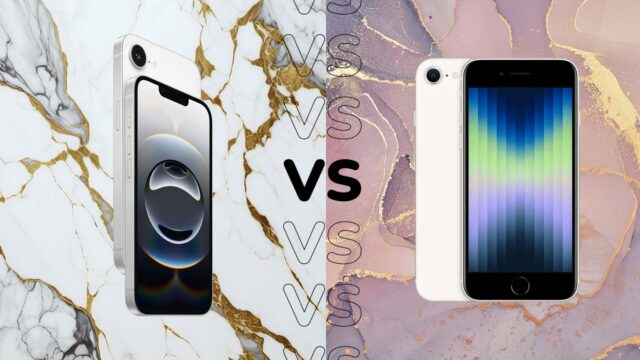Apple has unveiled the new iPhone 16e – but what’s new compared to 2022’s iPhone SE?
Despite the new branding, the iPhone 16e is essentially the new iPhone SE, taking the place of the previous mid-ranger as Apple’s new affordable iPhone.
Unlike previous iPhone SE upgrades, however, the iPhone 16e is a total overhaul of Apple’s budget-friendly iPhone. It not only ditches the aged design for a more modern look, but it sports a larger OLED panel, a better camera and much more.
Here’s how the iPhone 16e compares to 2022’s iPhone SE 3 on paper.
Price & availability
The iPhone SE 3 was Apple’s entry-level iPhone with a price tag to match, coming in at £429/$429 with just 64GB of storage. It’s no longer available to buy from Apple directly following the launch of the 16e, but it’s still available from third-party retailers while they try to shift the remaining stock.
The iPhone 16e, despite being a spiritual successor to the SE, comes in at a more premium £599/$599. It’ll be available to pre-order from 21 February 2025 ahead of release on 28 February 2025.
The iPhone 16e sports a much more modern look
The iPhone SE 3 has a dated design, there’s no two ways about it. Sharing the same design as the iPhone 8, a phone released in 2017, the iPhone SE 3 was the last holdout in Apple’s iPhone collection. The rest of the collection shifted to a new all-screen design, first with the iPhone X, and then again with the flat-sided iPhone 12 and later.
The iPhone 16e finally rights those wrongs with a design that looks much more like a modern iPhone. That includes a new full-screen design, rounded corners, flat edges and a rear that doesn’t look too dissimilar to the iPhone 16, albeit with just a single rear camera.

That also includes other recent amenities including the move from Lightning to USB-C, though you won’t find the Action Button or Camera Capture controls here – those remain exclusive to Apple’s flagship iPhone collection.
The iPhone 16e ditches Touch ID for Face ID
To stay in line with the rest of Apple’s modern iPhone collection, the new iPhone SE does away with the Home button and, with it, support for Touch ID. Though many will no doubt lament the loss of the last Touch ID-powered iPhone, the introduction of a notch with Face ID smarts is certainly an upgrade.
Just like with more modern iPhones, the iPhone 16e can scan your face to unlock your iPhone, authenticate payments and much more, and it’ll work in any conditions, not just in well-lit rooms.
The notch itself isn’t Apple’s most recent iteration, opting for the old-school notch in place of the more advanced Dynamic Island on Apple’s flagship range, but it’s still a welcome addition.
The iPhone 16e features a larger OLED screen
With a redesigned chassis that no longer requires the Home button, the iPhone 16e has extra room to accommodate a larger display than its predecessor.


That said, the iPhone 16e measures in at 6.1 inches, offering a not-insignificant increase of 1.4 inches compared to the older 4.7-inch iPhone SE – and that’s not all that’s new either.
Along with a boosted resolution that brings the display in line with the iPhone 16, the iPhone 16e also sports an OLED panel, offering more vivid colours and way deeper blacks than its LCD-based predecessor did.
It’s an all-round upgrade of Apple’s budget iPhone’s display, though it’s still stuck at 60Hz. Still, considering the iPhone 16 is also capped at 60Hz, that’s not a huge surprise.
The iPhone 16e is much more powerful
The iPhone SE 3 shared the same A15 Bionic chipset as the iPhone 13, the flagship iPhone released the year before. That provided a serious boost to performance power that allowed the iPhone to outperform the mid-range competition in benchmarks, something that lasted for quite some time.
Continuing this trend, the iPhone 16e features the same A18 chipset as the flagship iPhone 16 that launched in late 2023, offering similar performance to Apple’s flagship.
This is undoubtedly one of the strongest points of the new iPhone SE, allowing it to run more modern apps and games and keep pace with the rest of the mid-range smartphone market, if not some flagships.
The iPhone 16e offers a higher-res rear camera
The iPhone SE 3’s single 12MP rear camera was fine, but it wasn’t exactly exceptional compared to similarly priced Android alternatives.


Thankfully, the iPhone 16e introduces an upgraded 48MP OIS-enabled main camera – the same as that from recent models of iPhone – for an upgraded snapping experience.
There’s still only a single camera on the rear of the device however, and some shooting modes (rather oddly) remain exclusive to Apple’s more premium models of iPhone despite sharing key camera and processing hardware.
Those who want more cameras will still need to invest in either an iPhone 16 or iPhone 16 Pro, though the upgraded 48MP sensor should provide 2x digital zoom for added versatility.
Early thoughts
The iPhone 16e looks to be a complete overhaul of the device, fixing most of our complaints about the previous budget-friendly iPhone’s dated design and small, low-res screen.
Some will surely lament the loss of Apple’s last ‘true’ small-screen iPhone with a larger 6.1-inch panel this time around, but there’s no denying that the new iPhone 16e offers way more bang for your buck than the previous model ever did.











